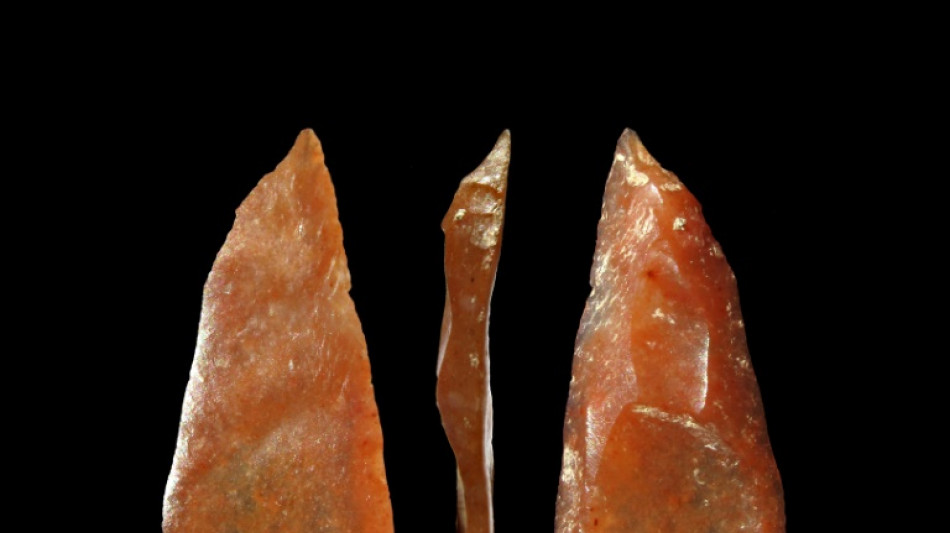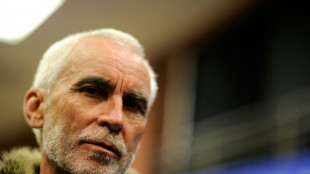
-
 Marseille go top in Ligue 1 as Lens thrash Monaco
Marseille go top in Ligue 1 as Lens thrash Monaco
-
Fourteen-man South Africa fight back to beat France

-
 Atletico, Villarreal win to keep pressure on Liga giants
Atletico, Villarreal win to keep pressure on Liga giants
-
Chelsea down Wolves to ease criticism of Maresca's rotation policy

-
 England's Genge eager to face All Blacks after Fiji win
England's Genge eager to face All Blacks after Fiji win
-
Wasteful Milan draw at Parma but level with Serie A leaders Napoli

-
 Fire kills six at Turkish perfume warehouse
Fire kills six at Turkish perfume warehouse
-
Djokovic pulls out of ATP Finals with shoulder injury

-
 Rybakina outguns world No.1 Sabalenka to win WTA Finals
Rybakina outguns world No.1 Sabalenka to win WTA Finals
-
Norris survives a slip to seize Sao Paulo pole

-
 Sunderland snap Arsenal's winning run in Premier League title twist
Sunderland snap Arsenal's winning run in Premier League title twist
-
England see off Fiji to make it nine wins in a row

-
 Australia connection gives Italy stunning win over Wallabies
Australia connection gives Italy stunning win over Wallabies
-
Arsenal winning run ends in Sunderland draw, De Ligt rescues Man Utd

-
 Griezmann double earns Atletico battling win over Levante
Griezmann double earns Atletico battling win over Levante
-
Title-leader Norris grabs Sao Paulo Grand Prix pole

-
 Djokovic edges Musetti to win 101st career title in Athens
Djokovic edges Musetti to win 101st career title in Athens
-
Rybakina downs world No.1 Sabalenka to win WTA Finals

-
 McKenzie ends Scotland dream of first win over New Zealand
McKenzie ends Scotland dream of first win over New Zealand
-
McKenzie stars as New Zealand inflict heartbreak upon Scotland

-
 De Ligt rescues Man Utd in Spurs draw, Arsenal aim to extend lead
De Ligt rescues Man Utd in Spurs draw, Arsenal aim to extend lead
-
Kane saves Bayern but record streak ends at Union

-
 Bolivia's new president takes over, inherits economic mess
Bolivia's new president takes over, inherits economic mess
-
Edwards set for Wolves job after Middlesbrough allow talks

-
 COP30: Indigenous peoples vital to humanity's future, Brazilian minister tells AFP
COP30: Indigenous peoples vital to humanity's future, Brazilian minister tells AFP
-
Marquez wins Portuguese MotoGP sprint race

-
 Saim, Abrar star in Pakistan's ODI series win over South Africa
Saim, Abrar star in Pakistan's ODI series win over South Africa
-
Norris extends title lead in Sao Paulo GP sprint after Piastri spin

-
 Man Utd have room to 'grow', says Amorim after Spurs setback
Man Utd have room to 'grow', says Amorim after Spurs setback
-
Tornado kills six, wrecks town in Brazil

-
 Norris wins Sao Paulo GP sprint, Piastri spins out
Norris wins Sao Paulo GP sprint, Piastri spins out
-
Ireland scramble to scrappy win over Japan

-
 De Ligt rescues draw for Man Utd after Tottenham turnaround
De Ligt rescues draw for Man Utd after Tottenham turnaround
-
Israel identifies latest hostage body, as families await five more

-
 England's Rai takes one-shot lead into Abu Dhabi final round
England's Rai takes one-shot lead into Abu Dhabi final round
-
Tornado kills five, injures more than 400 in Brazil

-
 UPS, FedEx ground MD-11 cargo planes after deadly crash
UPS, FedEx ground MD-11 cargo planes after deadly crash
-
Luis Enrique not rushing to recruit despite key PSG trio's absence

-
 Flick demands more Barca 'fight' amid injury crisis
Flick demands more Barca 'fight' amid injury crisis
-
Israel names latest hostage body, as families await five more

-
 Title-chasing Evans cuts gap on Ogier at Rally Japan
Title-chasing Evans cuts gap on Ogier at Rally Japan
-
Russian attack hits Ukraine energy infrastructure: Kyiv

-
 Kagiyama tunes up for Olympics with NHK Trophy win
Kagiyama tunes up for Olympics with NHK Trophy win
-
Indonesia probes student after nearly 100 hurt in school blasts

-
 UPS grounds its MD-11 cargo planes after deadly crash
UPS grounds its MD-11 cargo planes after deadly crash
-
Taliban govt says Pakistan ceasefire to hold, despite talks failing

-
 Trump says no US officials to attend G20 in South Africa
Trump says no US officials to attend G20 in South Africa
-
Philippines halts search for typhoon dead as huge new storm nears

-
 Bucks launch NBA Cup title defense with win over Bulls
Bucks launch NBA Cup title defense with win over Bulls
-
Chinese ship scouts deep-ocean floor in South Pacific


Study places Homo sapiens in Europe earlier than thought
Homo sapiens ventured into Neanderthal territory in Europe much earlier than previously thought, according to an archaeological study published in Science magazine on Wednesday.
Up to now, archaeological discoveries had indicated that Neanderthals disappeared from the European continent about 40,000 years ago, shortly after the arrival of their "cousin" Homo sapiens, barely 5,000years earlier and there was no evidence of an encounter between these two groups.
The new discovery, by a team of archaeologists and palaeoanthropologists led by Ludovic Slimak of Toulouse University, pushes back the arrival of Homo sapiens in Western Europe to around 54,000 years ago.
Another remarkable finding of the research is that the two types of humans alternated in inhabiting the Mandrin cave in what is now the Rhone region of southern france.
The Mandrin site, first excavated in 1990, includes layer upon layer of archaeological remains dating back over 80,000 years.
"Mandrin is like a kind of neandertalian Pompeii, without catastrophic events, but with continuous filling of sands in the cave deposited progressively by a strong wind, the Mistral," Slimak told AFP.
His team uncoevered a layer, known as the "E layer", containing at least 1,500 cut flint points, more finely executed than the points and blades in the layers above and below.
Very small in size, some of them less than a centimetre in length, these points "are standardised, to the nearest millimetre, something we haven't seen at all with Neanderthals," said Slimak, a specialist in Neanderthal societies.
These, he explained, were probably arrowheads, unknown in Europe at that time.
He attributes this production to a culture called Neronian, linked to several sites in the Rhone area.
- Milk tooth discovery -
In 2016, Slimak and his team visited the Peabody Museum in Harvard to compare their discoveries with a collection of carved fossils from the Ksar Akil site at the foot of Mount Lebanon, one of the major sites of the expansion of Homo sapiens to the east of the Mediterranean.
The similarity between the techniques used convinced Slimak that the findings at the Mandrin site were the first traces of Home Sapiens found in Europe.
A milk tooth found in the "E layer" confirmed his suspicions.
In all researchers found nine teeth at the Mandrin cave site, belonging to six individuals.
These ancient teeth were entrusted to Clement Zanolli, a palaeoanthropologist at the University of Bordeaux.
Using microtomography, similar to medical scanning technology, the verdict was clear.
The milk tooth from the "E" layer" was the only modern human tooth found at the site.
That "fossil molar from a modern human child provides the earliest known evidence of modern humans in western Europe", the Natural History Museum in London said in a statement.
- Co-existence? -
The archaeological team then used a pioneering technique, fuliginochronology, which analyses layers of soot impregnating the walls of a cave and the traces of ancient fires.
The reachers demonstrated that "this Modern human population occupied this Rhone territory for some 40 years," said Slimak.
At some point, the two populations either co-existed in the cave or on the same territory, the researcher concluded.
He imagines that Neanderthals could have served as guides to Homo Sapiens to lead him to the best sources of flint available, some of which were located up to 90 kilometres (55 miles away.
"Nothing new under the sun… This is precisely what happened when Europeans began the colonization of the Americas or Australia," he noted.
"The findings from Mandrin are really exciting and are another piece in the puzzle of how and when modern humans arrived in Europe,? concludes Professor Chris Stringer, co-author of the study and a specialist in human evolution at the Natural History Museum in London.
"Understanding more about the overlap between modern humans and other hominins in Eurasia is vital to understanding more about their interactions, and how we became the last remaining human species," he added.
This overlap, which was evident in Mandrin, now places the Rhone region as a "major migration corridor (for Homo sapiens) enabling them to reach the Mediterranean and continental European areas", said Slimak, who promises more discoveries from the Mandrin site.
D.Kaufman--AMWN



